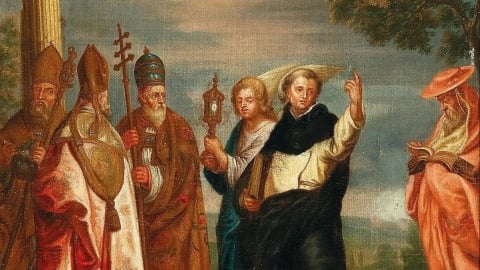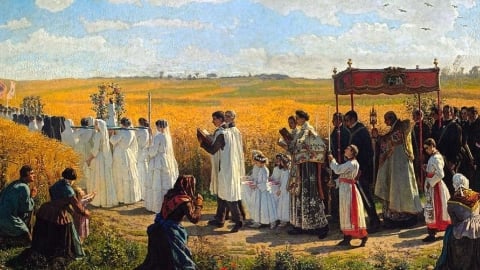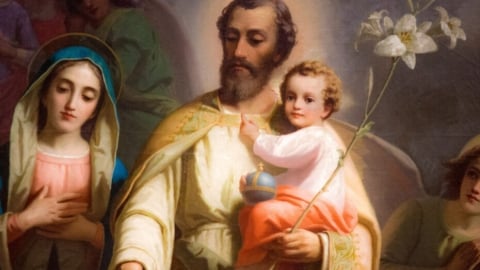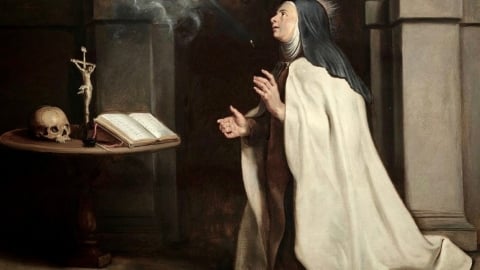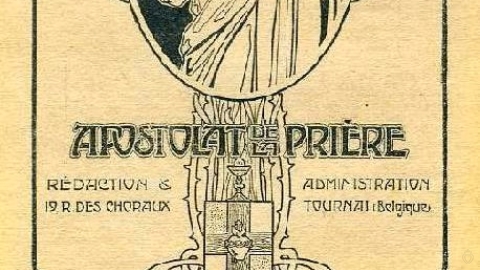Fr. John Baptist Scaramelli SJ (1687–1752)

John Baptist Scaramelli was born in Rome, December 23, 1687. At the age of eighteen, having finished the study of philosophy, he entered the novitiate of the Society of Jesus at St. Andrea in Rome. Here, on September 21, 1708, he pronounced his first vows, and remained at St. Andrea for another year to study rhetoric.
During the novitiate years at St. Andrea, Scaramelli had a splendid opportunity of laying a solid foundation for his religious life. His superiors and spiritual directors were all men of exceptional knowledge and practice of religious perfection. His rector and master of novices during his first year novitiate was Father Fabio Mansi, a man conspicuous for his self-abnegation and for his prudence and skill in the direction of others. The socius to the master of novices, during this first year, was Father Fortunatus Accarigi, who was looked upon by his contemporaries as a living compendium of the rules of St. Ignatius and a man filled with God.
Because of his proficiency in the humanities, Scaramelli was required to spend but one year in the study of rhetoric, instead of the usual two; and because of his previous study of philosophy before he entered the Society, he was dispensed entirely from the customary three-year course in this subject. Accordingly, in 1709, he was sent to the college at Ragusa in Umbria, to act as prefect and to teach the humanities. In 1712 he was transferred to the college at Loreto where he performed similar duties for two more years. Returning to Rome in 1714, he began the study of theology at the Ro-man College. In his second year of theology, he was appointed “repetitor” or tutor, in philosophy at the German College. He was ordained to the priesthood in 1717, and completed his theological studies the following year, during which he also acted as tutor in theology for the German students, and sodality director for the younger seminarians.
There on February 2, 1721, he made his final profession of the four solemn vows of the Society. By this time, superiors had decided that Scaramelli's greatest talent lay in his ability as a preacher and as a director of souls. In 1722 he was sent to Ascoli to assume the duties of assistant pastor and preacher for the “Bona Mors” sodality. The following year he was assigned to missionary work, a work that was to become his principal occupation for the rest of his life. About this same time, Father Francis Bianchi, who was also just beginning his missionary career, was appointed companion to Scaramelli, a partnership that was to he dissolved only by Scaramelli's death. For more than twenty-five years, these two missionaries travelled the length and breadth of Italy, preaching in the public squares, conducting penitential processions through the streets of the cities, teaching and exhorting the people from the pulpit, hearing confessions and administering the Bread of Life to countless multitudes. During the season of Lent, and during the summer months, the missionaries usually separated to occupy some pulpit as special Lenten preachers, or to conduct retreats for priests, seminarians or religious women.
In their manner and style of preaching, Scaramelli and Bianchi adapted themselves, of course, to the character of the Italian people and to the method of preaching popular missions in vogue in that day. This method is graphically portrayed for us in a printed and highly laudatory account of a mission preached by Scaramelli and Bianchi in the town of Pesaro in the year 1730. A summary of this document will provide a splendid testimony of the remarkable zeal and success of the two missionaries, and indicate the strenuous life they led in their quest for souls.
“The mission began with a formal reception of the missionaries at the gates of Pesaro. Escorted thither from a nearby town by a delegation of the religious confraternities, Scaramelli and Bianchi were met at the gates of the town by the bishop, his chapter, the clergy, and a great gathering of the populace. After an address of welcome by the bishop, who also presented Scaramelli with a large mission cross, a procession was formed and they all marched into the town. In the centre of the procession, behind the clergy and the religious confraternities, was carried a large miraculous picture of the Mater Misericordiae which belonged to Scaramelli. It was encased in a highly ornate frame of silver plate, with two adoring angels suspended from brackets on the sides. A rich, ornamented cloth hung below the picture, and from the folds of this cloth protruded six candlesticks. The whole was mounted on a platform and carried on the shoulders of four privileged members of the confraternities. Behind this picture, the populace, singing hymns and the litany of the Blessed Virgin, marched to the large court-yard of the bishop's palace, appropriately decorated for the occasion, and already filled with other thousands of the people. Here, in the court-yard, Father Scaramelli preached the opening discourse «che fu assai tenero e compuntivo (which was very tender and compunctious).» About seven thousand people participated at these opening functions, the number increasing daily at the various sermons, catechetical instructions, and especially at the penitential processions.
In these processions the bishop himself set the good example by marching bare-foot, wearing a crown of thorns on his head and a rope about his neck. Other members of the clergy, together with about thirty laymen emulated him. Some carried a death's head, some wore a crown of thorns, some bore a heavy cross, others were clothed in hairshirts, or dragged heavy weights tied to their hands, and very many beat themselves with scourges, even to the shedding of blood. This holy spectacle of penitence was repeated for three successive evenings. The procession would halt at the more important public squares, where Father Bianchi would deliver a sermon in an effort to win over the more hardened and obstinate sinners. Then, the pious penitents, their number greatly augmented, would wend their way back to the cathedral, chanting, as they went, a sad and solemn dirge concerning the Four Last Things. During the day the magistrates and nobility, ladies as well as knights, participated at all the sacred functions, so that for fifteen days the whole city was engaged in nothing else but recollection, retirement, and signs of real interior compunction, manifested particularly at the confessionals, where from early morning till late at night the crowds gathered in great numbers. At the end of the mission, general communion was distributed by the bishop. Then Father Scaramelli gave the Papal benediction to about twenty thousand people in the public square.”
Scaramelli began and ended his missionary career at Macerata. Much of his free time must have been spent travelling from place to place on these missionary campaigns. But when not actually engaged in missionary or retreat work, he lived at one of the various colleges of the Society. According to the annual catalogues, he made his headquarters at Macerata from 1725 to 1728; at Monte Santo for the next three years, and then again at Macerata till 1738. For the next twelve years, he was attached to the community at San Sepolcro, where, according to tradition, most of his books were written. In 1750 he was assigned once more to the community at Macerata, where within two weeks after his return from a prolonged missionary expedition, he died, January 11, 1752, at the age of sixty-four.
His Spiritual works:
It is not, however, because of his missionary achievements that Scaramelli's name has come down to posterity. His place in history is due primarily to his influence on succeeding generations through his ascetical and mystical writings. In view of his very active life as a missionary, preacher, and retreat director, it would seem that he could have had very little leisure for study and writing. Yet, Scaramelli is the author of six learned books, two of which, the Direttorio Mistico and the Direttorio Ascetico, have earned him an important place in the history of Christian spirituality
His first published work, Vita di Suor Maria Crocifissa Satellico is the biography of a Franciscan nun of the monastery of Monte Nuovo, whose life of great austerity and extraordinary trials was richly crowned with the highest mystical graces. The Discernimento degli Spiriti deals with the rules which help a person to determine «the quality of his own spirit, that is, to understand whom he has for guide of his thoughts and affections, whether the devil, self-love, or God». It is based on the shorter treatises of St. Ignatius and Alvarez de Paz on the same subject, but is greatly enhanced by the author's own experiences and practical advice. His most popular work, Direttorio Ascetico, is a lengthy treatise which «teaches the manner of conducting souls to Christian perfection by the ordinary ways of divine grace ». Dottrina di San Giovanni della Croce is a succinct compendium of the works of St. John of the Cross, in which the very words of that Spanish Doctor of mysticism are often made use of. Vita della Servo di Dio, Angelina Cospari still in manuscript form, is the edifying account of the virtues and graces of a laywoman, who amidst great bodily suffering enjoyed the highest mystical favours.
